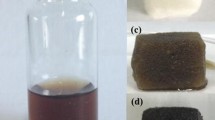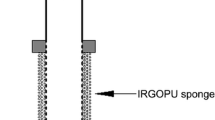Abstract
The spillage of oil and hydrophobic volatile organic compounds (VOCs) has become a global challenge that removing them from the environment is essential to the health of living organisms. The superhydrophobic sponges are considered as an excellent absorbent to clean up oil/solvent spills due to high absorption capacity and elasticity. The most important challenges in creating superhydrophobic sponges are to increase absorption capacity, selectivity, and thermal stability by developing the surface area, water contact angle, and coated materials, respectively. In this study, in order to enhance surface area, reduced graphene oxide–titanium dioxide (TiO2) nanocomposite was applied on a substrate of raw and carbonized melamine sponge by a simple dip coating method. The results show that better bonding of synthesized nanocomposite to carbonized sponge fibers leads to a greater increase in surface area than modified raw sponge. Besides, hydrophilicity property of raw sponge varies to superhydrophobicity after modification to the contact angle of 161.5° and 165.1° for raw and carbonized sponge, respectively. Modified sponges with high thermal stability reduce the risk of fire. The maximum oil/organic solvents absorption capacity for modified melamine sponge was reported 169 times of its weight, which is increased for carbonized sponge due to higher porous volume and lower density. They also demonstrated good recycle ability after 15 times, repeating the absorption–squeezing process. These outstanding features make them an exceptional candidate absorber for various oils and hydrophobic VOCs.













Similar content being viewed by others
References
Ruan C, Ai K, Li X, Lu LA (2014) A superhydrophobic sponge with excellent absorbency and flame retardancy. Angew Chem Int Ed 126:5662–5666
Pham VH, Dickerson JH (2014) Superhydrophobic silanized melamine sponges as high efficiency oil absorbent materials. ACS Appl Mater Interfaces 6:14181–14188
Wang CF, Lin SJ (2013) Robust superhydrophobic/superoleophilic sponge for effective continuous absorption and expulsion of oil pollutants from water. ACS Appl Mater Interfaces 5:8861–8864
Allan SE, Smith BW, Anderson KA (2012) Impact of the Deepwater Horizon oil spill on bioavailable polycyclic aromatic hydrocarbons in Gulf of Mexico coastal waters. Environ Sci Technol 46:2033–2039
Zahed MA, Aziz HA, Isa MH, Mohajeri L, Mohajeri S (2010) Optimal conditions for bioremediation of oily seawater. Bioresour Technol 101:9455–9460
Atlas RM (1995) Petroleum biodegradation and oil spill bioremediation. Mar Pollut Bull 31:178–182
Mullin JV, Champ MA (2003) Introduction/overview to in situ burning of oil spills. Elsevier, Amsterdam
Broje V, Keller AA (2007) Effect of operational parameters on the recovery rate of an oleophilic drum skimmer. J Hazard Mater 148:136–143
Chapman H, Purnell K, Law RJ, Kirby MF (2007) The use of chemical dispersants to combat oil spills at sea: a review of practice and research needs in Europe. Mar Pollut Bull 54:827–838
Lv X, Tian D, Peng Y, Li J, Jiang G (2019) Superhydrophobic magnetic reduced graphene oxide-decorated foam for efficient and repeatable oil-water separation. Appl Surf Sci 466:937–945
Salehi S, Anbia M (2017) High CO2 adsorption capacity and CO2/CH4 selectivity by nanocomposites of MOF-199. Energy Fuels 31:5376–5384
Tornero V, Hanke G (2016) Chemical contaminants entering the marine environment from sea-based sources: a review with a focus on European seas. Mar Pollut Bull 112:17–38
Mustafa Salih Y, Rahim Karim A, Khorshid I (2018) Estimation the time of spill crude oil in deep soil by the detection of volatile organic compounds (VOCs). J Pet Sci Technol 36:497–1502
Huang B, Lei C, Wei C, Zeng G (2014) Chlorinated volatile organic compounds (Cl-VOCs) in environment—sources, potential human health impacts, and current remediation technologies. Environ Int 71:118–138
Zhang X, Gao B, Creamer AE, Cao C, Li Y (2017) Adsorption of VOCs onto engineered carbon materials: a review. J Hazard Mater 338:102–123
Poddar TK, Majumdar S, Sirkar KK (1996) Membrane-based absorption of VOCs from a gas stream. AlChE J 42:3267–3282
Daniel C, Antico P, Yamaguchi H, Kogure M, Guerra G (2016) Microporous-crystalline microfibers by eco-friendly guests: an efficient tool for sorption of volatile organic pollutants. Microporous Mesoporous Mater 232:205–210
Lalanne F, Malhautier L, Roux JC, Fanlo JL (2008) Absorption of a mixture of volatile organic compounds (VOCs) in aqueous solutions of soluble cutting oil. Bioresour Technol 99:1699–1707
Zou L, Luo Y, Hooper M, Hu E (2006) Removal of VOCs by photocatalysis process using adsorption enhanced TiO2–SiO2 catalyst. Chem Eng Process 45:959–964
Heymes F, Manno-Demoustier P, Charbit F, Fanlo JL, Moulin P (2006) A new efficient absorption liquid to treat exhaust air loaded with toluene. Chem Eng J 115:225–231
Cheng Y, He H, Yang C, Zeng G, Li X, Chen H, Yu G (2016) Challenges and solutions for biofiltration of hydrophobic volatile organic compounds. Biotechnol Adv 34:1091–1102
Darracq G, Couvert A, Couriol C, Amrane A, Thomas D, Dumont E, Andres Y, Le Cloirec P (2010) Silicone oil: an effective absorbent for the removal of hydrophobic volatile organic compounds. J Chem Technol Biotechnol 85:309–313
Uragami T, Matsuoka Y, Miyata T (2016) Permeation and separation characteristics in removal of dilute volatile organic compounds from aqueous solutions through copolymer membranes consisted of poly (styrene) and poly (dimethylsiloxane) containing a hydrophobic ionic liquid by pervaporation. J Memb Sci 506:109–118
Anbia M, Salehi S (2012) Synthesis of polyelectrolyte-modified ordered nanoporous carbon for removal of aromatic organic acids from purified terephthalic acid wastewater. Chem Eng Res Des 90:975–983
Fan W, Liu X, Zhang Z, Zhang Q, Ma W, Tan D, Li A (2014) Conjugated microporous polymer nanotubes and hydrophobic sponges. Microporous Mesoporous Mater 196:335–340
Deng CH, Gong JL, Zhang P, Zeng GM, Song B, Liu HY (2017) Preparation of melamine sponge decorated with silver nanoparticles-modified graphene for water disinfection. J Colloid Interface Sci 488:26–38
Feng Y, Wang Y, Wang Y, Zhang XF, Yao J (2018) In-situ gelation of sodium alginate supported on melamine sponge for efficient removal of copper ions. J Colloid Interface Sci 512:7–13
Huang J, Xu Y, Zhang X, Lei Z, Chen C, Deng Y, Wang C (2018) Polyethylenimine and dithiocarbamate decorated melamine sponges for fast copper (II) ions removal from aqueous solution. Appl Surf Sci 445:471–477
Chatzimitakos TG, Stalikas CD (2018) Melamine sponge decorated with copper sheets as a material with outstanding properties for microextraction of sulfonamides prior to their determination by high-performance liquid chromatography. J Chromatogr A 1554:28–36
Stolz A, Le Floch S, Reinert L, Ramos SM et al (2016) Melamine-derived carbon sponges for oil-water separation. Carbon 107:198–208
Gao H, Sun P, Zhang Y, Zeng X, Wang D, Zhang Y, Wang W, Wu J (2018) A two-step hydrophobic fabrication of melamine sponge for oil absorption and oil/water separation. Surf Coat Technol 339:147–154
Fan W, Lai Q, Zhang Q, Wang Y (2011) Nanocomposites of TiO2 and reduced graphene oxide as efficient photocatalysts for hydrogen evolution. J Phys Chem C 115:10694–10701
Darvishi M, Seyed-Yazdi J (2016) Characterization and comparison of photocatalytic activities of prepared TiO2/graphene nanocomposites using titanium butoxide and TiO2 via microwave irradiation method. Mater Res Express. https://doi.org/10.1088/2053-1591/3/8/085601
Zhou X, Zhang Z, Xu X, Men X, Zhu X (2013) Facile fabrication of superhydrophobic sponge with selective absorption and collection of oil from water. Ind Eng Chem Res 52:9411–9416
Song S, Yang H, Su C, Jiang Z, Lu Z (2016) Ultrasonic-microwave assisted synthesis of stable reduced graphene oxide modified melamine foam with superhydrophobicity and high oil adsorption capacities. Chem Eng J 306:504–511
Latthe SS, Imai H, Ganesan V, Rao AV (2010) Porous superhydrophobic silica films by sol–gel process. Microporous Mesoporous Mater 130:115–121
Giffard K, Arurault L, Blanc C (2016) Dynamic measurements and wettability phenomena in mesoporous anodic films prepared on 1050 and 2024T3 aluminium alloys. Microporous Mesoporous Mat 235:32–41
Drelich J (1997) The effect of drop (bubble) size on contact angle at solid surfaces. J Adhes 63:31–51
Paulchamy B, Arthi G, Lignesh BD (2015) A simple approach to stepwise synthesis of graphene oxide nanomaterial. J Nanomed Nanotechnol. https://doi.org/10.4172/2157-7439.1000253
Yang MQ, Zhang N, Xu YJ (2013) Synthesis of fullerene–, carbon nanotube–, and graphene–TiO2 nanocomposite photocatalysts for selective oxidation: a comparative study. ACS Appl Mater Interfaces 5:1156–1164
Jafarpour M, Ghahramaninezhad M, Rezaeifard A (2014) characterization and catalytic activity of oleic acid-coated TiO2 nanoparticles carrying MoO2 (acac)2 in the oxidation of olefins and sulfides using economical peroxides. New J Chem 38:2917–2926
Pinjari DV, Pandit AB (2011) Room temperature synthesis of crystalline CeO2 nanopowder: advantage of sonochemical method over conventional method. Ultrason Sonochem 18:1118–1123
Zhu H, Chen D, An W, Li N, Xu Q, Li H, He J, Lu J (2015) A robust and cost-effective superhydrophobic graphene foam for efficient oil and organic solvent recovery. Small 11:5222–5229
Liu T, Zhao G, Zhang W, Chi H, Hou C, Sun Y (2015) The preparation of superhydrophobic graphene/melamine composite sponge applied in treatment of oil pollution. J Porous Mater 22:1573–1580
Nguyen DD, Tai NH, Lee SB, Kuo WS (2012) Superhydrophobic and superoleophilic properties of graphene-based sponges fabricated using a facile dip coating method. Energy Environ Sci 5:7908–7912
Ge J, Shi LA, Wang YC, Zhao HY et al (2017) Joule-heated graphene-wrapped sponge enables fast clean-up of viscous crude-oil spill. Nat Nanotechnol 12:434–440
Oribayo O, Feng X, Rempel GL, Pan Q (2017) Synthesis of lignin-based polyurethane/graphene oxide foam and its application as an absorbent for oil spill clean-ups and recovery. Chem Eng J 323:191–202
Acknowledgements
The authors are thankful to the Research Council of Iran University of Science and Technology (Tehran) for financial support to this study.
Author information
Authors and Affiliations
Corresponding author
Additional information
Publisher's Note
Springer Nature remains neutral with regard to jurisdictional claims in published maps and institutional affiliations.
Electronic supplementary material
Below is the link to the electronic supplementary material.
Supplementary material 1 (MPG 8176 kb)
Supplementary material 2 (MPG 12346 kb)
Supplementary material 3 (MPG 9818 kb)
Supplementary material 4 (MPG 11010 kb)
Supplementary material 5 (MPG 13138 kb)
Rights and permissions
About this article
Cite this article
Mirhosseinian, N.S., Anbia, M. & Salehi, S. Preparation and characterization of superhydrophobic melamine and melamine-derived carbon sponges modified with reduced graphene oxide–TiO2 nanocomposite as oil absorbent materials. J Mater Sci 55, 1536–1552 (2020). https://doi.org/10.1007/s10853-019-04110-6
Received:
Accepted:
Published:
Issue Date:
DOI: https://doi.org/10.1007/s10853-019-04110-6




